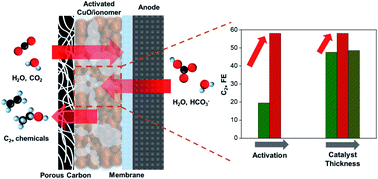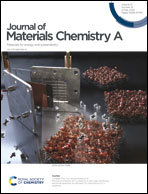Microenvironments of Cu catalysts in zero-gap membrane electrode assembly for efficient CO2 electrolysis to C2+ products†
Abstract
A zero-gap membrane-electrode assembly (MEA) electrolyzer is a promising design for electrochemical CO2 reduction reactions (eCO2RRs), where gaseous CO2 is directly fed without catholyte. The zero-gap junction between the catalyst and the membrane can have distinct chemical environments and mass transfer properties from the conventional H-type cell but is rarely studied. In this work, we designed an integrated experimental-simulation study in MEA to understand the zero-gap junction and factors to determine the eCO2RR activity to multi-carbon production. We developed a simple synchronous ionomer/catalyst activation step under alkaline conditions to form jagged CuO nanoparticles whose unique morphological evolution facilitates the C2+ chemical production for the zero-gap MEA electrolyzer. Moreover, under gas-fed and high–current density conditions, computational fluid dynamics suggests that the mass transfer limitation of water as a proton source across the catalyst-membrane layer and cathode kinetic overpotential are critical to determining C2+ chemical production in the range of several micrometers. From the chemical-physical understanding, we achieved a high partial current density of 336.5 mA cm−2 and a faradaic efficiency of 67.3% towards C2+ chemicals.

- This article is part of the themed collection: Journal of Materials Chemistry A HOT Papers


 Please wait while we load your content...
Please wait while we load your content...